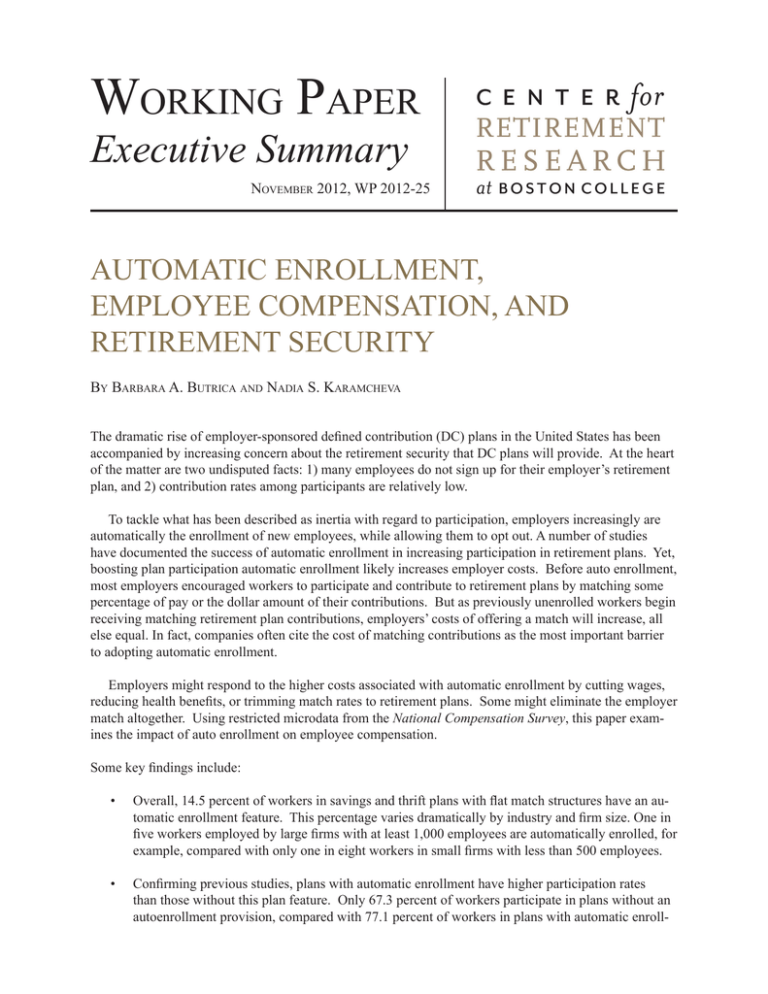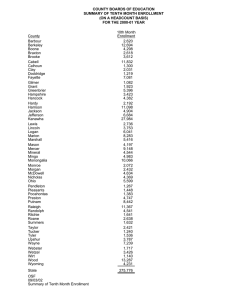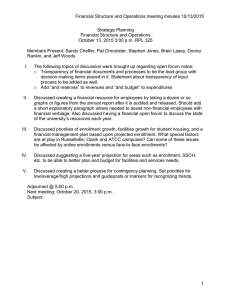
Working PaPer
Executive Summary
november 2012, WP 2012-25
AUTOMATIC ENROLLMENT,
EMPLOYEE COMPENSATION, AND
RETIREMENT SECURITY
B
The dramatic rise of employer-sponsored defined contribution (DC) plans in the United States has been
accompanied by increasing concern about the retirement security that DC plans will provide. At the heart
of the matter are two undisputed facts: 1) many employees do not sign up for their employer’s retirement
plan, and 2) contribution rates among participants are relatively low.
To tackle what has been described as inertia with regard to participation, employers increasingly are
automatically the enrollment of new employees, while allowing them to opt out. A number of studies
have documented the success of automatic enrollment in increasing participation in retirement plans. Yet,
boosting plan participation automatic enrollment likely increases employer costs. Before auto enrollment,
most employers encouraged workers to participate and contribute to retirement plans by matching some
percentage of pay or the dollar amount of their contributions. But as previously unenrolled workers begin
receiving matching retirement plan contributions, employers’ costs of offering a match will increase, all
else equal. In fact, companies often cite the cost of matching contributions as the most important barrier
to adopting automatic enrollment.
Employers might respond to the higher costs associated with automatic enrollment by cutting wages,
reducing health benefits, or trimming match rates to retirement plans. Some might eliminate the employer
match altogether. Using restricted microdata from the National Compensation Survey, this paper examines the impact of auto enrollment on employee compensation.
Some key findings include:
•
Overall, 14.5 percent of workers in savings and thrift plans with flat match structures have an automatic enrollment feature. This percentage varies dramatically by industry and firm size. One in
five workers employed by large firms with at least 1,000 employees are automatically enrolled, for
example, compared with only one in eight workers in small firms with less than 500 employees.
•
Confirming previous studies, plans with automatic enrollment have higher participation rates
than those without this plan feature. Only 67.3 percent of workers participate in plans without an
autoenrollment provision, compared with 77.1 percent of workers in plans with automatic enroll-
ment. Even controlling for other factors, auto enrollment is associated with higher plan participation rates; however, the difference between plans with and without automatic enrollment is
slightly diminished – by 7 percentage points.
•
There is strong evidence that employer match behavior is correlated with auto enrollment. The
potential match rate averages 3.5 percent for workers without automatic enrollment but is only 3.2
percent for those with automatic enrollment. Regression models that control for industry, establishment size, the share of workers with defined-benefit pensions, full-time employment, union
membership, and region show that match rates are 0.4 percentage points lower among plans with
automatic enrollment than among those without automatic enrollment.
•
Employers with auto enrollment plans must set a default contribution rate for employees who do
not actively select a contribution rate. With these defaults, it is possible for employers to match an
even lower percentage of their workers’ salaries. The average default match rate in our sample is
only 1.8 percent – 1.4 percentage points lower than the potential match rate.
•
Another way to overcome workers’ inertia is to automatically escalate the default contribution rate
for employees, and 22 percent of plans in our sample do this. Yet even with automatic escalation,
the maximum default match rate averages only 2.1 percent – still 1.1 percentage points lower than
the potential match rate. Thus, on average, firms in our sample are defaulting their workers at a
contribution rate at which workers cannot take full advantage of the employer match.
•
Employers with autoenrollment plans pay significantly higher wages and benefits than those without auto enrollment. Among workers in savings and thrift plans with automatic enrollment, for
example, hourly wages average $28 per labor hour, health insurance benefits average $4 per labor
hour, and total costs average $41 per labor hour. In contrast, for those without auto enrollment,
hourly wages average $26 per labor hour, health insurance benefits average $3 per labor hour, and
total costs average $38 per labor hour.
•
Controlling for other factors, however, our results show no statistically significant difference between the total compensation paid by employers of plans with and without automatic enrollment.
•
Decomposing total costs, we find no evidence that firms with autoenrollment have DC costs that
are different – higher or lower – from those without autoenrollment. We also find no evidence
that these firms have different non-DC costs, nor any evidence that DC costs crowd out non-DC
costs.
•
A more careful analysis of employers’ costs shows that auto enrollment is associated with higher
costs for health insurance, but lower costs for defined benefit pensions – with the size of the coefficients nearly offsetting each other.
Most pension-related research has focused on individuals’ behavior – whether workers participate in
a 401(k), how much they contribute, and how they make investment choices. Even the discussion surrounding automatic enrollment has focused on how it benefits employees by increasing their pension
coverage and ultimately their retirement savings. Comparatively little is known about employer decisions
regarding retirement plans, yet employer actions surrounding these plans substantially affect future retirement security. By boosting plan participation, automatic enrollment likely increases employer costs as
previously unenrolled workers receive matching retirement plan contributions. Employers might respond
to the surge in retirement plan costs associated with automatic enrollment by trimming match rates to
401(k) plans or reducing other compensation.
We find that employer match rates are negatively and significantly correlated with auto enrollment,
even when we control for other factors. Not only do employers with auto enrollment have lower potential
match rates than those without, but also their default match rates are, on average, lower than the match
threshold. By setting their default match rates lower than potential match rates, employers can contribute to the accounts of more workers without necessarily increasing their costs. Our findings suggest that
employers might be doing exactly this, since we find no evidence that total costs differ between firms
with and without automatic enrollment. Furthermore, we find no evidence that DC costs crowd out other
forms of compensation – suggesting that firms might be lowering their potential and/or default match
rates enough to completely offset the higher costs of automatic enrollment without needing to reduce
other compensation costs.
While autoenrollment is likely to boost the retirement savings of workers who would not participate
without it, our findings suggest it could lead to lower account balances at retirement for those who were
already enrolled or would have enrolled anyway. Furthermore, the prospect of lower match rates may not
only reduce employer contributions to retirement accounts, but might also lower workers’ contributions.
© 2012, Barbara A. Butrica and Nadia S. Karamcheva. All rights reserved. The research reported herein was performed pursuant
to a grant from the U.S. Social Security Administration (SSA) funded as part of the Retirement Research Consortium (RRC).
The opinions and conclusions expressed are solely those of the authors and do not represent the views of SSA, any agency of the
federal government, the RRC, the Urban Institute, or Boston College.
center for retirement reSearch at boSton college
Hovey House, 140 Commonwealth Avenue, Chestnut Hill, MA 02467-3808
phone 617.552.1762 fax 617.552.0191 crr@bc.edu crr.bc.edu




